
Top 25 Rankings 1901-1935
1908 National Championship
Home
1908
College Football Top 25
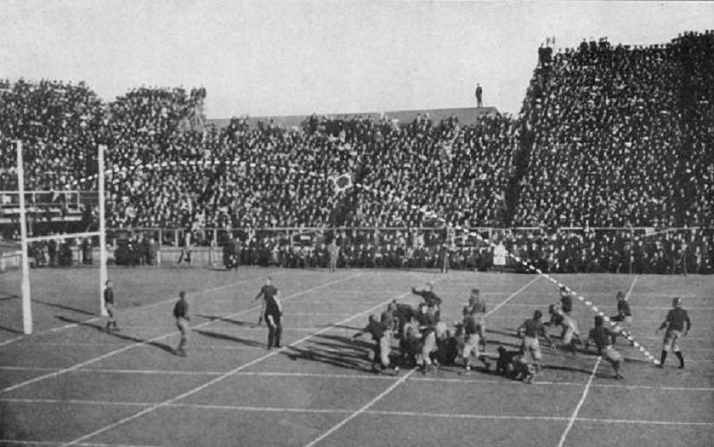
Pictured above is Harvard substitute Vic Kennard's field goal that beat Yale 4-0. The photo comes from the 1916 book Football Days by William Edwards, in which the trajectory of the winning kick was helpfully illustrated, the ball circled in the middle.
Although
retroactive selectors prefer 11-0-1 Pennsylvania as the "national
champion" of 1908, at that time, the Harvard-Yale game was considered
to be the "national championship" game, and after 9-0-1 Harvard beat
7-1-1 Yale, Harvard would have finished #1 by a very comfortable
margin in a 1908 AP poll. Had Yale won, they would have been considered the national champion.
I
summarized and compared 8-0-1 Harvard and 11-0-1 Penn, as well as 5-0-1 Chicago and 10-0 Louisiana State, in great detail,
in my 1908 national
championship article.
Harvard #1, Penn #2.
#3: Yale vs. Chicago vs. Cornell
7-1-1
Yale would have almost certainly been #3 in a 1908 AP poll, and that
works fine. Their loss, again, came 4-0 to #1 Harvard. Their tie was
with 5-3-1 Brown (will be rated #12), but they defeated 6-1-2 Army
(#10), 6-3-1 Syracuse (#14), 5-2-3 Princeton (#15), and 10-2-1
Washington & Jefferson (#21), and that's more wins against top 25
teams than Chicago and Cornell managed combined.
7-1-1 Cornell might have been rated higher than 5-0-1 Chicago, and
Eastern writers seemed certain that Cornell was better, but the 2 teams
tied (at Chicago), and Chicago was unbeaten, so we'll rate them next.
Chicago also defeated 2 top 25 teams to 1 for Cornell, and Chicago only
had 2 close wins, over 5-1 Wisconsin and 5-1-1 Illinois, while
Cornell's 2 close wins came over 5-5 Penn State and 3-3-2 Amherst, much
worse teams. The 2 top 25 teams Chicago defeated were 5-1 Wisconsin
(#9) and 3-2-1 Minnesota (#18), and 5-1-1 Illinois would have been
about #32-34.
7-1-1 Cornell took their loss 17-4 at #2 Penn. Their best wins came
9-0 over 4-3 Colgate (#13) and 10-4 over 5-5 Penn State (#26-31).
Yale #3, Chicago #4, and Cornell #5.
Carlisle, Dartmouth, Army, Navy, and Wisconsin
My guess is that the next teams to be rated in a 1908 AP poll would have been the following, in this order:
10-2-1 Carlisle, 6-1-1 Dartmouth, 6-1-2 Army, and 9-2-1 Navy. Carlisle
and Dartmouth are fine. 10-2-1 Carlisle took their losses at #1 Harvard
and at #18 Minnesota, and they tied #2 Pennsylvania. Their last 10
games were all on the road, and included wins at 9-2-1 Navy (will be
rated #8), 6-3-1 Syracuse (#14), 7-2-1
Nebraska (#19), 7-1 Denver (#22), 5-5 Penn State (#26-31), 8-3
Pittsburgh (#32-34), and 6-2-2 St. Louis. That schedule is just crazy.
7-1-1 Dartmouth took their loss just 6-0 at #1 Harvard, their best
result, but they took a tie against unrated 3-3-2 Williams, their
worst. They defeated just 1 rated opponent, winning 10-6 over 5-2-3
Princeton (#15).
However, though 6-1-2 Army defeated 9-2-1 Navy 6-4 in their finale, Navy should be rated higher because
they actually had the better relevant record.
The head-to-head win gives Army a 1 game lead on Navy. Army lost 6-0 to
#3 Yale, a strong showing, but they took their ties to #15 Princeton
and #21 Washington & Jefferson. Those ties bring them back to even
with Navy, but still holding the head-to-head tiebreaker. Navy's other
loss came to #6 Carlisle, who is rated higher, so that loss is
irrelevant when comparing Navy to Army. But Navy's tie came to #1
Harvard, arguably the best result by any team this season, and it is
this game that gives Navy a relevant record that is effectively a half
game better than Army's. Furthermore, Navy performed better than Army,
as their only close win came over a good team, 5-5 Penn State (#26-31),
while Army posted close wins over a pair of bad teams, Springfield and
Tufts.
5-1 Wisconsin probably would have been ranked behind all these teams,
but it's possible that they would have been ranked ahead of Army, and
they performed better than Army, so we're going to bring them in ahead
of Army. Wisconsin posted 2 close wins, both over good teams (#18
Minnesota and #32-34 Marquette), while Army posted 2 close wins over
bad teams, as noted above. Wisconsin's loss came 18-12 to 5-0-1 Chicago
(#4). Navy can remain ranked ahead of Wisconsin, as they posted just 1
close win (over #26-31 Penn State).
Carlisle #6, Dartmouth #7, Navy #8, Wisconsin #9, and Army #10.
Louisiana State, Brown,
Colgate, Syracuse, and Princeton
10-0 Louisiana
State got a bit more national attention than did most Southern token teams
from this time, so I believe they would have ranked about #11, though
it is possible that they would have been ranked significantly lower. I
summarized their season in some detail in my 1908 national championship article.
Next we'll bring in our usual clot of Eastern teams that played tough schedules and thus took a bunch of losses and ties:
5-3-1 Brown, 4-3 Colgate, 6-3-1 Syracuse, and 5-2-3 Princeton. 5-3-1
Brown took their losses to #1 Harvard (by just 4 points), #2 Penn, and
6-2-2 Lafayette (#20). The tie was their best "win," as it came at #3
Yale, but they also won 6-0 over Colgate.
4-3 Colgate took their other 2 losses to #5 Cornell and #10 Army.
They had one big win, 6-0 at Syracuse. 6-3-1 Syracuse took their
other 2 losses to #3 Yale and #6 Carlisle. Their tie came at Princeton,
and they won 28-4 over 5-2-1 Michigan (#16).
5-2-3 Princeton
took their losses to #3 Yale and #7 Dartmouth, and in addition to
Syracuse, they tied #10 Army and #20 Lafayette. They did not defeat a
rated team, and unlike Syracuse they had one poor performance against
an unrated team, so Syracuse should be rated higher.
Louisiana State #11, Brown #12, Colgate #13, Syracuse #14, and Princeton #15.
Colgate
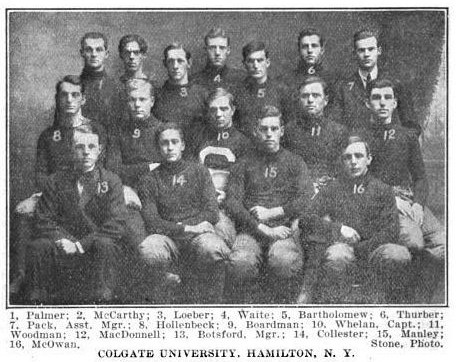
Colgate's
coach, here for just this one season, was Cornell grad Edwin Sweetland
(pictured below). He had previously gone a terrific 20-5-2 at rival
Syracuse 1900-1902, and after a 14-7-2 stint at Ohio State, he came to
Colgate this season and coached the school's first top 25 caliber team.
Likewise, in 1909 he would coach Kentucky to their first top 25 season. Overall Sweetland was 100-41-10 at 9 schools.
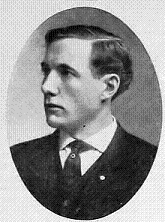
Believe
it or not, until the 1950s, Colgate-Syracuse was a fierce and famous
rivalry. Coming into 1908, Colgate was 7-3-1 against Syracuse. 1908 was
the first game of the series held at Syracuse's Archbold Stadium (more
on that in the Syracuse section below), where the series would always
be played afterward until it was ended in 1961. This rivalry attracted
such huge crowds that it needed to be played in a large venue.
Colgate's
6-0 win over Syracuse in 1908 was the start of a so-called "Hoodoo"
curse Colgate enjoyed against Syracuse in the stadium. Syracuse had 8
drives that went inside the Colgate 10 in this game, but yielded no
points. What other explanation could there be other than a curse?
According to legend, a Colgate student had placed a varsity maroon "C"
sweater in the drying cement of the stadium as it was being built,
initiating the curse. Colgate won the first 5 games of the series
played at the stadium, they won 10 in a row 1928-1937, and through 1949
they led the series 31-15-5. Colgate fans continually chanted
"Hoodoo" when their team played Syracuse. Syracuse fans answered
with a chant of "We do!"
The schools took very different paths in the 1950s, killing the
rivalry. Syracuse re-emphasized football in the decade and enjoyed the
school's greatest football period, culminating in a national
championship in 1959. Colgate, on the other hand, went the Ivy League
route, de-emphasizing football and becoming a minor/lower division
football program. As a result, Syracuse started stomping on Colgate in
the 1950s, and the series was ended in 1961. The schools have played
each other 5 times since, the most recent game being played in 2016.
That game was Syracuse's 16 straight win over Colgate, finally tying
the series up at 31-31-5.
Syracuse
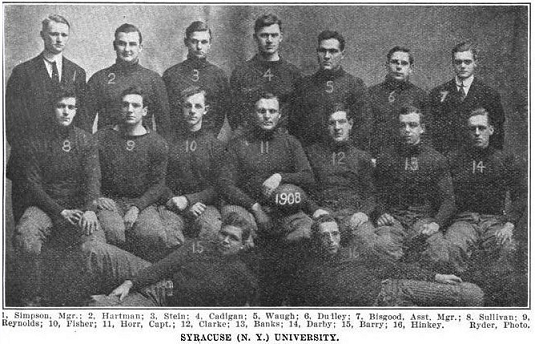
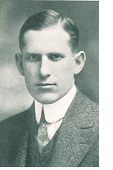 Syracuse
was also led by a coach who was here for just one season, Hall of Famer
Howard Jones (pictured at left). He had played for Yale 1905-1907, winning 3 straight
national championships with them, and he had just graduated in the
Spring, so this was the debut season of his very illustrious coaching
career. The next season, 1909, he coached Yale to another national
championship. Later he went 42-17-1 at Iowa 1916-1923 with 2 Big 10
titles and another MNC, then 121-36-13 at Southern Cal 1925-1940 with 7
PCC titles and another 2 MNCs (the school claims 4 MNCs). Total
for his career: 194-64-21 and 4 legit MNCs (plus another 3 as a player!).
Syracuse
was also led by a coach who was here for just one season, Hall of Famer
Howard Jones (pictured at left). He had played for Yale 1905-1907, winning 3 straight
national championships with them, and he had just graduated in the
Spring, so this was the debut season of his very illustrious coaching
career. The next season, 1909, he coached Yale to another national
championship. Later he went 42-17-1 at Iowa 1916-1923 with 2 Big 10
titles and another MNC, then 121-36-13 at Southern Cal 1925-1940 with 7
PCC titles and another 2 MNCs (the school claims 4 MNCs). Total
for his career: 194-64-21 and 4 legit MNCs (plus another 3 as a player!).
Syracuse
was led on the field by consensus All American tackle Bill Horr, who
won a pair of medals in discus events at the 1908 Olympics. End Claude
Fisher and guard Orlo Waugh were nonconsensus AA.
The
aforementioned Archbold Stadium (pictured below) was the 3rd concrete stadium in America
when built. It held 20,000, but until the 1950s, when it was doubled in
size to accommodate a surge in ticket demand, it was generally only filled for the annual rivalry game with
nearby Colgate. The stadium first started hosting games in 1907, but
construction was not complete until 1908. Dr. Charles Burrows wrote in Technical World
magazine in 1909, "Athletic contests may come and go, but the recently
completed concrete stadium of Syracuse University will last forever."
It was demolished after the 1978 season to make way for the Carrier
Dome.

Michigan, Kansas, Minnesota, and Nebraska
5-2-1 Michigan
took their losses to #2 Penn and #14 Syracuse, and the tie came at
6-0-2 Michigan State (#23). They won 12-6 over 8-1 Notre Dame (#26-31),
16-6 over 6-3-1 Case, 10-6 at 6-4 Ohio State, and 24-6 over 7-2-1 Vanderbilt (who
lost to Ohio State). I believe that Missouri Valley champion 9-0 Kansas
would have been rated lower, and they did perform worse than Michigan,
so we'll bring them in next. Kansas won 20-5 at 7-2-1 Nebraska (#19),
12-6 over 6-2 Kansas State (unrated), and 10-4 over arch-rival 6-2
Missouri (unrated) in their finale, but the rest of their schedule was
very poor, and they barely won at 2-5 Iowa.
3-2-1 Minnesota took their losses to #4 Chicago and #9 Wisconsin,
and the tie came to Nebraska at home. They posted a pair of weak wins
over 3-4 Lawrence and 6-3 Iowa State (unrated), but they pulled off one
huge win 11-6 over #6 Carlisle in their finale.
In addition to Kansas, 7-2-1 Nebraska lost 37-6 to #6 Carlisle, and
as noted, they tied Minnesota. That was their one big "win" of the year.
Michigan #16, Kansas #17, Minnesota #18, and Nebraska #19.
Kansas
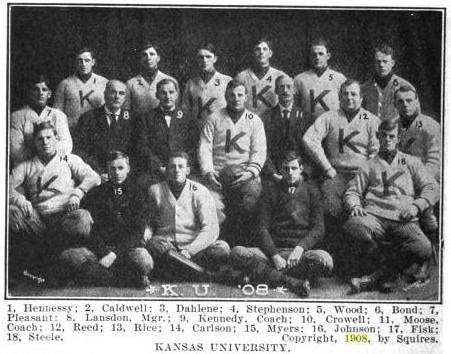
Kansas was coached by Dr. Bert Kennedy (#9 in team picture
above), who had played quarterback at Kansas 1895-1897 and at Penn in
1899. He went 7-0-1 at Washburn (Kansas) in 1903, then Kansas hired him
away and he went 52-9-4 here 1904-1910. Overall he was 96-43-10 at 3
schools. But football coaching was just a hobby: he was a practicing dentist for 62 years. Kansas was top 25 caliber in 2 of Kennedy's seasons, then not again until 1947.
Kansas quarterback Tommy Johnson went 23-2-1 as a starter
1908-1910. He scored the only touchdown on a fumble return in a 5-3 win
at Kansas State in 1909, and he scored the only touchdown on a 70 yard
punt return in a 6-0 win at Nebraska the same season. But
unfortunately, he suffered a concussion and was rendered ineffective in
the 1909 finale against Missouri, and Kansas lost for the first time
since 1907. Worse, that gave the conference title to Missouri. In 1910,
Tommy Johnson would suffer a collision in a 5-5 tie with Missouri that
aggravated a kidney condition he'd had since childhood, and he died a
year later of kidney failure.
End Carl Pleasant and center John
"Swede" Carlson were All-Missouri Valley, and giant guard Howard "Tub"
Reed, who weighed in at 240 pounds, was both All-Missouri Valley and
All-Western (which included the Big 10 region, so was a tougher list to
make).
Lafayette and Washington & Jefferson
6-2-2 Lafayette
and 10-2-1 Washington & Jefferson fall in behind Nebraska primarily
because Minnesota defeated #6 Carlisle, and Nebraska tied Minnesota.
Lafayette took their losses to #2 Penn and 4-3 Lehigh (unrated). Their
ties came to #15 Princeton, a good result, and to 3-5-2 Bucknell, a
poor result. They pulled off one big win, 8-6 at #12 Brown. So in the
end, they had a loss and a tie against higher-rated teams, and a loss
and a tie against unrated teams. Erratic but balanced.
10-2-1 Washington & Jefferson took their losses to #3 Yale and
to 9-1 Western Reserve (#24). However, they tied #10 Army, and that
plus Western Reserve's upset loss to 7-1-1 Kenyon (unrated;
lost to 6-4 Ohio State and tied 6-3-1 Case), puts W&J ahead of
Western Reserve despite the head-to-head result (better relevant
record). W&J also defeated 8-3 Pittsburgh.
Lafayette #20 and Washington & Jefferson #21.
Washington & Jefferson
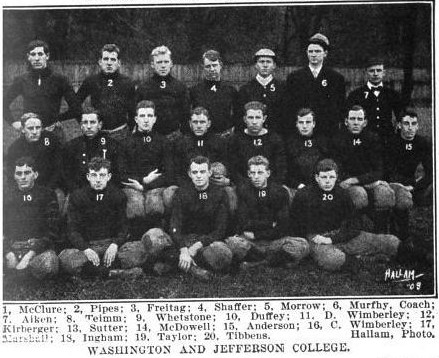
Washington & Jefferson was coached by David Morrow (#5 in team
picture above), a Bethany (West Virginia) grad who hung around at
Washington & Jefferson for more than 20 years. This was his first
season as head coach, and he went 27-11-3 here 1908-1911. He was head
coach for 2 more stints, going 11-5-1 from 1919-1920 and 13-4-1 from
1924-1925. That put him at 51-20-5 in all. Washington & Jefferson
was top 25 in 5 of his 8 seasons. In 1908 Washington & Jefferson
became the first football team to put numbers on their jerseys.
Denver, Michigan State, Western Reserve, and Washington
Time to finish
out the top 25 with a bunch of token teams, starting with Rocky
Mountain champion 7-1 Denver. Their best result was their loss, by a
mere 8-4 to #6 Carlisle. That's better than all of the following teams
did against Carlisle:
#8 Navy, #14 Syracuse, and #19 Nebraska. Denver defeated 3-2-1 Utah,
5-2 Colorado, and 5-2 Colorado College, all in very close games.
6-0-2 Michigan State took their ties to #16 Michigan and to unrated
6-0-1 DePaul. All of DePaul's other opponents were minor teams,
extremely low level (Knox, Carroll, Lake Forest, Beloit, Illinois
State). Michigan State did not defeat a good team, and they struggled
to get by 2-6 Wabash, so the big tie with Michigan is all they
accomplished.
9-1
Western Reserve was the Ohio Athletic Conference champion. They took
their loss to unrated 7-1-1 Kenyon, but they made up for it with a big
upset win over #21 Washington & Jefferson. Western Reserve defeated
6-4 Ohio State and 6-3-1 Case.
6-0-1 Washington was the
Northwestern champion. They tied 4-0-2 Washington State (who took their
other tie to Idaho), and they defeated Oregon and Oregon State.
Denver #22, Michigan State #23, Western Reserve #24, and Washington #25.
Denver
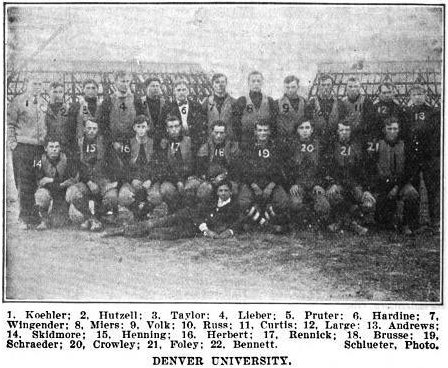
Denver's coach was John Koehler, who had played at Nebraska and
then at Chicago for Amos Alonzo Stagg. He went 22-15-1 here 1906-1910
and won 2 conference titles. This was Denver's first conference title,
and their first top 25 team, something they would accomplish only one
more time, in 1917. Denver fielded 5 players who were All-Rocky
Mountain this season. Halfback Clem Crowley became a referee and
a prominent football writer, in addition to his day job as a lawyer.
Michigan State

This was Michigan State's first top 25 caliber team. They had been
a minor team playing mostly minor teams, but they made a name for
themselves for the first time this year when they tied mighty Michigan
(they had previously been 0-3 against Michigan). This was also the first year
Michigan played in East Lansing. The coach who lifted them up from
nowheresville was Chester Brewer, a Wisconsin grad who went a very
impressive 56-10-6 here 1903-1910. He then moved on to Missouri, and
overall he was 97-51-14 at 4 schools, nowhere near as successful
at any other time as he was at Michigan State 1903-1910. Brewer became
the athletic director at Missouri 1923-1935, and he remained a
professor there until his death.
Western Reserve
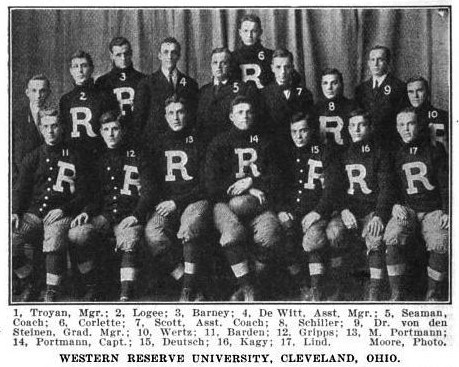
Western Reserve had gone 9-1 in 1907 as well, but this season was
their only team that was ever top 25. The coach, William "Budget" Seaman,
went 26-7-4 here 1906-1909. Four Western Reserve players were All-Ohio
this season.
Others
Receiving Votes
Here
are the teams closest to making this top 25. 5-0 Arizona and 6-0 Louisiana-Lafayette
were too far removed from big time
football to consider.
Notre Dame 8-1
8-1 Notre Dame took their loss by just 12-6 at #16 Michigan. They
won 6-0 at 4-2-1 Marquette (covered below), but posted a weak performance in struggling to get by 2-6
Wabash.
Auburn 6-1
6-1 Auburn lost
10-2 to #11 Louisiana State. They defeated 4-1-3 Sewanee, 6-3 Georgia
Tech, and 5-2-1 Georgia. Their power level might well have been top 25.
Miami (Ohio) 7-0
7-0 Miami-Ohio posted close wins over all of the following teams: Centre, Ohio, Oberlin, and Wabash. Highly unlikely that their power level was top 25.
Washington State 4-0-2
As previously
mentioned, 4-0-2 Washington State tied #25 Washington and unrated 2-2-2
Idaho. They did not beat a good team (and did not play Oregon or Oregon
State).
Penn State 5-5
5-5 Penn State
took their losses to #2 Penn, #5 Cornell, #6 Carlisle, #8 Navy, and
to unrated Bellefonte Academy in their opener. That last was an
ugly result, but PSU was within a touchdown of 3 of the top 10 teams
they lost to, and they won 12-6 at 8-3 Pitt (covered below) in their
finale. It is likely that their power level was top 25.
Pittsburgh 8-3
In addition to
Penn State (covered above), 8-3 Pittsburgh lost to #6 Carlisle and #21
Washington & Jefferson. They won 13-0 at 6-2-2 St. Louis, and they
defeated 5-3 West Virginia and 7-2 Gettysburg at home.
Illinois 5-1-1
5-1-1 Illinois
lost a close 11-6 game at #4 Chicago, and they tied 4-2-1 Marquette
(covered below). They did not beat a good team, but all of their wins
came by more than a touchdown.
Marquette 4-2-1
4-2-1 Marquette
took their losses to #9 Wisconsin (by just 3 points) and to 8-1 Notre
Dame (covered above), and they tied 5-1-1 Illinois (covered above). All
of their wins came by big scores, though the opponents in those games
were all minor teams. I think it is quite possible that Notre Dame,
Illinois, and Marquette were all top 25 in power level.
DePaul 6-0-1
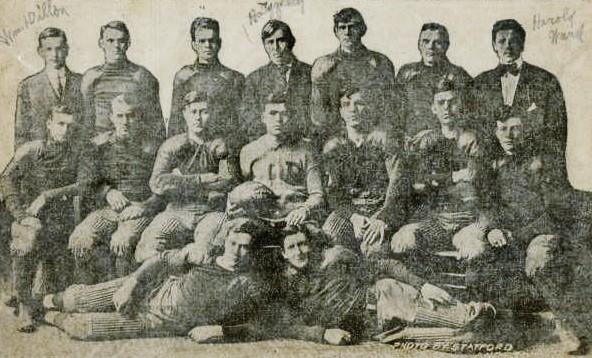
6-0-1
DePaul tied #23 Michigan State. The rest of their opponents were all
minor teams, and they struggled to get by 5-3 Illinois State. This is
the closest DePaul ever came to being top 25 caliber. The coach was
Frank Hagerty (middle of back row in team picture above), a Colby grad
who went 5-2 here in 1907 and 6-0-1 this season. DePaul fielded 5
players who were All-Illinois this year, and they also featured end Joe
Wilhoit, who became a professional baseball player, best known for his
record 69-game hitting streak at minor league team Wichita, which is
still the professional baseball record.
1908
Top 25
1)
Harvard 9-0-1
2) Pennsylvania 11-0-1
3) Yale 7-1-1
4) Chicago 5-0-1
5) Cornell 7-1-1
6) Carlisle 10-2-1
7) Dartmouth 6-1-1
8) Navy 9-2-1
9) Wisconsin 5-1
10) Army 6-1-2
11) Louisiana State 10-0
12) Brown 5-3-1
13) Colgate 4-3
14) Syracuse 6-3-1
15) Princeton 5-2-3
16) Michigan 5-2-1
17) Kansas 9-0
18) Minnesota 3-2-1
19) Nebraska 7-2-1
20) Lafayette 6-2-2
21) Washington & Jefferson 10-2-1
22) Denver 7-1
23) Michigan State 6-0-2
24) Western Reserve 9-1
25) Washington 6-0-1
Others
Receiving Votes:
Notre Dame 8-1
Auburn 6-1
Miami (Ohio) 7-0
Washington State 4-0-2
Penn State 5-5
Pittsburgh 8-3
Illinois 5-1-1
Marquette 4-2-1
DePaul 6-0-1





 Syracuse
was also led by a coach who was here for just one season, Hall of Famer
Howard Jones (pictured at left). He had played for Yale 1905-1907, winning 3 straight
national championships with them, and he had just graduated in the
Spring, so this was the debut season of his very illustrious coaching
career. The next season, 1909, he coached Yale to another national
championship. Later he went 42-17-1 at Iowa 1916-1923 with 2 Big 10
titles and another MNC, then 121-36-13 at Southern Cal 1925-1940 with 7
PCC titles and another 2 MNCs (the school claims 4 MNCs). Total
for his career
Syracuse
was also led by a coach who was here for just one season, Hall of Famer
Howard Jones (pictured at left). He had played for Yale 1905-1907, winning 3 straight
national championships with them, and he had just graduated in the
Spring, so this was the debut season of his very illustrious coaching
career. The next season, 1909, he coached Yale to another national
championship. Later he went 42-17-1 at Iowa 1916-1923 with 2 Big 10
titles and another MNC, then 121-36-13 at Southern Cal 1925-1940 with 7
PCC titles and another 2 MNCs (the school claims 4 MNCs). Total
for his career





